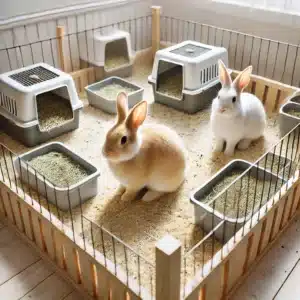Sharing a litter box between your bunnies can be a great way to maintain a clean and harmonious home environment. But is it always a good idea? And what are the best ways to make it work? In this article, we’ll explore how to help your rabbits share a litter box successfully, ensuring comfort, cleanliness, and happy cohabitation.
Key Points Covered
- Can rabbits share a litter box, and when does it work best?
- Important tips to encourage successful litter box sharing.
- How to deal with potential challenges like territorial behavior.
- Understanding the signs that sharing isn’t working for your rabbits.
- Practical steps for maintaining a clean and pleasant litter environment.
Can Bunnies Share a Litter Box?
Yes, bunnies can share a litter box, but it depends on a few important factors, such as their bond, personality, and space setup. Bonded pairs who are comfortable with each other and have formed a close connection are often more likely to share a litter box without any problems. However, rabbits that are not yet bonded or are new to each other might show territorial behavior, which can complicate litter box sharing.
The Importance of Bonding
The most important factor in successful litter box sharing is the bond between the rabbits. Bonded rabbits are more likely to see the litter box as a shared space, while unbonded rabbits may become territorial. To promote successful cohabitation, it’s crucial to invest time in bonding your rabbits properly. Start by introducing them in neutral spaces and ensure that both rabbits are spayed or neutered, as this reduces aggressive or territorial tendencies.

Tips for Encouraging Successful Litter Box Sharing
- Multiple Litter Boxes: In the beginning, provide multiple litter boxes throughout the space, especially if you have more than one rabbit. This gives each bunny an option, reducing territorial stress and encouraging them to get used to sharing.
- Fresh Hay: Place fresh hay in the litter box. Rabbits love to munch on hay while sitting in their litter box, and adding it can make the box more inviting for both bunnies. Always ensure hay is clean and free from contamination.
- Large Litter Boxes: Consider using a larger litter box or even a giant litter pan to comfortably accommodate both rabbits. A box that’s too small might lead to pushing, fighting, or discomfort.
- Clean Frequently: Rabbits are naturally clean animals, and keeping the litter box clean is crucial. Clean the litter box frequently to remove feces and replace soiled bedding. A clean box prevents odor buildup and makes both rabbits happy using the same space.
- Neutral Space Setup: Set up the litter box in a neutral area of the enclosure to minimize territorial instincts. If one rabbit thinks of the box as “theirs,” it could lead to conflict.
Potential Challenges and How to Address Them
- Territorial Behavior: Some rabbits may become territorial, even if they are bonded. Signs of territorial behavior include chasing, fighting, or pushing the other rabbit out of the litter box. If you notice this, try adding an extra litter box or placing boxes in different corners to give them more options.
- Health Concerns: It’s important to monitor your rabbits’ health when sharing a litter box. If one rabbit is sick or showing signs of diarrhea or other health issues, separating them and providing individual litter boxes can prevent the spread of illness.
- Observe Their Behavior: Watch your rabbits closely when introducing them to a shared litter box. If they seem comfortable and relaxed, and take turns using the box, it’s a good sign that sharing will work. However, if they show signs of stress or aggression, consider using separate boxes until they are more comfortable.

Maintaining a Clean and Pleasant Litter Environment
Keeping the litter box clean is not just about hygiene—it’s also about encouraging good habits. A dirty litter box might cause one or both rabbits to avoid it altogether. Use pet-safe bedding, clean it regularly, and always add fresh hay to make the space inviting. Providing a dedicated litter box “corner” in their pen or enclosure can help the rabbits understand where they should go.

When Sharing Isn’t Working
If your rabbits consistently fight over the litter box or avoid it due to territorial disputes, it might be best to provide separate litter boxes for each rabbit. This is common when rabbits are first introduced or if their bond isn’t strong enough yet. Separate boxes placed in different corners of the enclosure can help each rabbit feel secure and reduce competition.
Conclusion
Sharing a litter box is possible for many bonded rabbit pairs, but it requires patience, observation, and adjustments to meet their needs. By understanding your rabbits’ behaviors, providing enough space, and ensuring cleanliness, you can create a happy environment where both rabbits feel comfortable sharing their litter box.
FAQs
- Can two rabbits share one litter box?
Yes, bonded rabbits can share a litter box if it’s spacious enough and kept clean. However, some rabbits prefer having their own box. - What type of litter box is best for two rabbits?
A large litter box or a giant litter pan works well for two rabbits, providing them enough space to sit comfortably without crowding each other. - How do I prevent my rabbits from fighting over the litter box?
Make sure to provide multiple litter boxes and keep them clean. Bonded rabbits are less likely to fight, but it’s always good to have extra options. - How often should I clean the litter box?
Clean the litter box daily to remove feces and soiled bedding. Replace all bedding at least once a week to maintain hygiene. - Can I use a cat litter box for my rabbits?
Yes, a cat litter box can work well for rabbits, but make sure it’s large enough and avoid using clumping cat litter, as it can be harmful if ingested.



